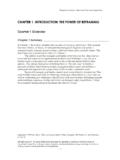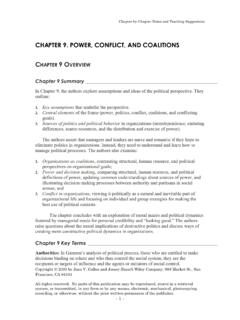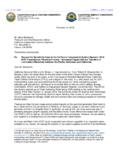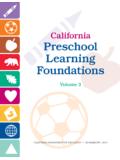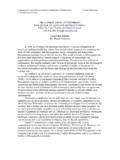Transcription of CHAPTER 7. IMPROVING HUMAN RESOURCE …
1 CHAPTER -by- CHAPTER Notes and Teaching SuggestionsCopyright 2003 by Joan V. Gallos and Jossey-Bass/A Wiley Company, 989 Market St., SanFrancisco, CA 94103 All rights reserved. No parts of this publication may be reproduced, stored in a retrievalsystem, or transmitted, in any form or by any means, electronic, mechanical, photocopying,recording, or otherwise, without the prior written permission of the 1 - CHAPTER 7. IMPROVING HUMAN RESOURCEMANAGEMENTCHAPTER 7 OVERVIEWC hapter 7 Summary_____In CHAPTER 7, the authors explore HUMAN RESOURCE approaches to organizationalimprovement strategies for investing in people that make organizations better and moreproductive places to work.
2 Table outlines six basic HUMAN RESOURCE strategies and aset of practices for implementing each:1. Build and implement a long-term HUMAN RESOURCE philosophy (develop a sharedphilosophy for managing people; build systems and practices to implement thephilosophy).2. Hire the right people (know what you want; be selective).3. Keep them (reward well; protect jobs; promote from within; share the wealth).4. Invest in them (invest in learning; create development opportunities).5. Empower them (provide information and support; encourage autonomy andparticipation; redesign work; foster self-managing teams; promote egalitarianism)6.
3 Promote diversity (be explicit and consistent about the organization s diversityphilosophy; hold managers accountable).The authors define each approach, provide relevant theory and research about its originand effectiveness, and illustrate how it carries HUMAN RESOURCE thinking intoorganizational design and managerial 7 Key Terms _____Gain-sharing plan: Plan that gives workers an incentive to reduce costs and improveefficiency by offering them a share of any gains realized from cost reductions andefficiency plan: Plan by which employees receive a bonus commensurate with thefirm s overall profitability or that of their local stock ownership plan (ESOP).
4 Plan by which employees receive companystock as a Notes and Teaching SuggestionsCopyright 2003 by Joan V. Gallos and Jossey-Bass/A Wiley Company, 989 Market St., SanFrancisco, CA 94103 All rights reserved. No parts of this publication may be reproduced, stored in a retrievalsystem, or transmitted, in any form or by any means, electronic, mechanical, photocopying,recording, or otherwise, without the prior written permission of the 2 -Open-book management: A management philosophy espousing the ideas that allemployees (1) should see and learn to understand the company s financial andperformance measures.
5 (2) should be encouraged think like owners, and (3) should have astake in the company s financial : A general term for management programs that give workers moreopportunity to influence decisions about their work and working : Herzberg s term for a work feature that produces worker satisfaction;motivators include achievement, recognition, responsibility, advancement, and factor: Herzberg s term for a work feature that produces worker dissatisfactionwhen below a certain threshold; hygiene factors include policies, supervision practices,and working enrichment: According to Herzberg, changing jobs to give workers more freedomand authority, more feedback, and greater challenges while making them moreaccountable and letting them use more quality management: A management approach aimed at IMPROVING customersatisfaction and hence long-term success through improvements in quality andproductivity.
6 Total quality management involves a comprehensive strategy emphasizingworkforce involvement, participation, and training: Management training to develop HUMAN relations skills throughincreased awareness of one s own feelings and the feelings of group: Small group, led by a trainer, in which sensitivity training is carried development (OD): A discipline aimed at IMPROVING organizations functioning through means based on HUMAN RESOURCE 7 Major Case Examples_____ David Owen s knitting mill in New Lanark, Scotland Federal Express Southwest Airlines Ritz Carlton hotel group Costco SAS Lincoln Electric United AirlinesChapter-by- CHAPTER Notes and Teaching SuggestionsCopyright 2003 by Joan V.
7 Gallos and Jossey-Bass/A Wiley Company, 989 Market St., SanFrancisco, CA 94103 All rights reserved. No parts of this publication may be reproduced, stored in a retrievalsystem, or transmitted, in any form or by any means, electronic, mechanical, photocopying,recording, or otherwise, without the prior written permission of the 3 - France s Carnaud Enron versus Springfield Remanufacturing (SRC Holdings) and Cin-Made The doll-painting factory Ascardio Health Care in Venezuela Ken Bamforth and the coal mine in South Yorkshire Whole Foods Markets Topeka s General Foods pet food plant Semco NUMMI Work Outs at General ElectricSUGGESTIONS FOR TEACHING CHAPTER 7 The central ideas in CHAPTER 7 revolve around HUMAN RESOURCE management can focus on:1.
8 Exploring some of the major approaches to organizational improvement discussed inthe CHAPTER , such as participative management and job Examining the interface between the structural and HUMAN RESOURCE methods appropriate for each approach are described in the sections that exercises keyed to the approaches appear in Student Exercises for CHAPTER 7, beginning on page 7: A Focus on Exploring Major Approaches to Organizational Improvement _____Because many HUMAN RESOURCE based approaches have made their way into the popularpress, students often come to the course knowing terms such as total qualitymanagement, job enrichment, and participative management, but with littleunderstanding of what the terms mean, why one approach might be chosen over another,and the kind of preparation that needs to be done before any of the approaches isinitiated.
9 Instructors can use this CHAPTER to explore these kinds of 7: Cases Focusing on Major Approachesto Organizational ImprovementA number of cases are perfect for exploring various approaches to organizationalimprovement. The classic Hovey and Beard Company case (which tells the doll-painting story) canbe used to explore job enrichment, an example of an early OD intervention thatinvolved participative management and self-managing work teams. Because the caseChapter-by- CHAPTER Notes and Teaching SuggestionsCopyright 2003 by Joan V. Gallos and Jossey-Bass/A Wiley Company, 989 Market St.
10 , SanFrancisco, CA 94103 All rights reserved. No parts of this publication may be reproduced, stored in a retrievalsystem, or transmitted, in any form or by any means, electronic, mechanical, photocopying,recording, or otherwise, without the prior written permission of the 4 -is old, it leads to lively discussion about the relevance of the suggestions and choicesfor today s workforce. (See William Whyte s Money and Motivation. New York:Harper & Row, 1955, pp. 90 94, for a detailed presentation of the case situation.) For a contemporary example, an excellent choice is Southwest Airlines: UsingHuman Resources for Competitive Advantage ([A] [HBS HR1A] and [B] [HBSHR1B]).
